![]()
![]()
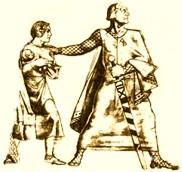
UNSTABLE TIMES AND DISORDER
Written by Gevork Nazaryan
Ani's rapid growth and expansion that took place during the rise of Bagratid power and the restoration of the Kingdom, halted with the untimely death of King Gagik I in 1020. King Gagik's two sons, Hovaness-Smbat and Ashot, became entangled in a deadly power struggle for the control of the throne and Kingdom. The conflict and strife brought forward instability and disorder to Ani and other parts of Greater Armenia. The two brothers, after years of fighting agreed to divide the the Kingdom into two parts, both holding the title of the King of Armenia. Ashot, who as reigning monarch became Ashot III, held the larger portion of the Kingdom, including Ani. In 1023 under the Byzantine pressure, Hovaness-Smbat, included in his Will the testimony to pass down that part of the Kingdom that was under his sovereignty to the Byzantine Empire. This in of itself brought a great resentment and caused a furor among Ani's citizenry, both rich and poor.

RUINS OF TIGNIS CASTLE THAT GUARDED ANI FROM THE
NORTH-EAST.
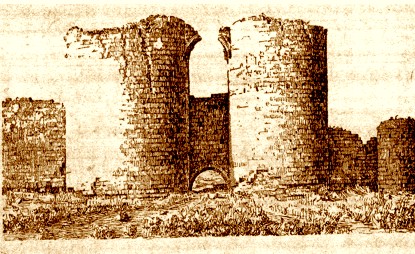
SECTION OF THE RUINS OF MASSIVE WALLS WITH ONE OF THE ARCHWAY
ENTRY
POINTS TO THE BAGRATID CAPITAL. DURING ATTACKS AND LONG SIEGES OF THE CITY
BY THE ENEMY ALL OF THE ENTRIES WERE BARRICADED WITH SOLID ROCK.
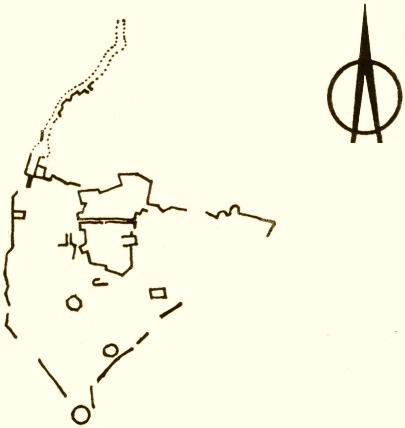
THE FLOOR PLAN OF THE CITADEL. RECONSTRUCTION BY MOSEVICH

RUINS OF AMBERD CASTLE. ONE OF THE STRONGHOLDS OF
PAHLAVUNI NOBILITY
THAT PLAYED A CRUCIAL ROLE IN THE LIFE OF ANI. PAHLAVUNIS WERE THE RIGHT HAND
AND THE MILITARY COMMANDERS OF ARMENIAN FORCES
UNDER BAGRATID KINGS. SPARAPET [COMMANDER] VAHRAM PAHLAVUNI
WAS ONE OF THE MOST DISTINGUISHED REPRESENTATIVES OF THE HOUSE
AND MILITARY LEADERS OF THE ERA.
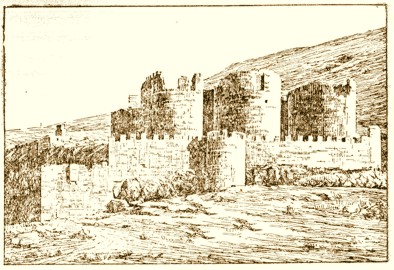
RUINS OF MAŁASBERD
FORTRESS THAT GUARDED ANI FROM THE SOUTH.
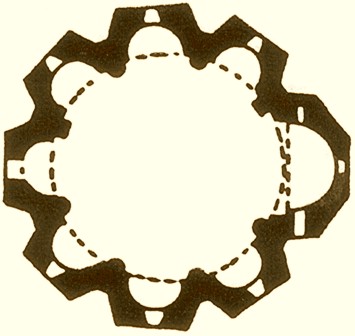
F L O O R P
L A N O F
E G H V A R D

THE VERNICLE. DETAIL OF THE FRESCO OF ANI'S CHURCH OF BAŁTAŁEG.
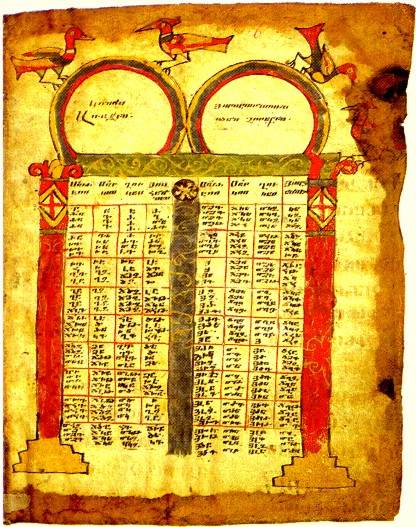

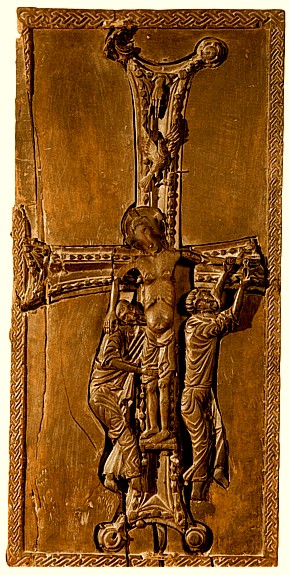
THE ALL-SAVIOR HOLY SYMBOL [SURB NŠAN]
FROM
HAVUC‛ T‛AR. IX-XTH CENTURIES.

RESURRECTION...EAGLE/PHOENIX WITH UPRAISED WINGS...THE SON/SUN
RISES
TOWARDS THE UNSEEN FATHER [SYMB. THE HAND WITH THE SIGN OF
JOHN/ON/OANNES/EA]. NOTE THE INTERWOVEN STRANDS ABOVE. SUPERBLY
MADE WORK BY ARMENIAN MASTERS WITH PROFOUND SACRED SYMBOLISM.
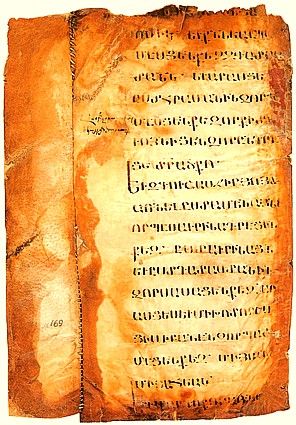
PARCHMENT OF ONE OF THE OLDEST SURVIVING ARMENIAN
MANUSCRIPTS FROM THE IXTH CENTURY IN YERKAT'AGIR FONT.

APPARITION OF CHRIST...ILLUMINATION FROM THE XITH CENTURY KARS
HOMILY.
CHRIST IS DEPICTED WITH THE PSYCHIC AURA THAT IS IN THE FORM OF AN
EQUILATERAL CROSS WITHIN A GOLDEN CIRCLE [THE SUN]... HIS RIGHT HAND IS
UPRAISED [SOLAR REJUVENATION]...WITH 2 FINGERS FOLDED AND 3
POINTING IN THE FORM OF A 'W' TO THE DISCIPLE...THE CHRIST SITS
UPON THE ROCK/MOUNTAIN [DIVINE SPARK] WITH THE SKY BLUE
BACKGROUND [HEAVENS...]...THE DISCIPLE HAS HIS HAND EXTENDED
WITH FIVE FINGERS AND OPEN PALM [INQUIRY...QUEST...]. THE BACKGROUND
DEPICTS RED TWO-FOLD PYRAMID THAT IS ONE OF THE ROYAL SYMBOLS
OF THE BAGRATID DYNASTY [PLACED ON THE WALLS OF ANI WITH THE
LOWER PERPEND. BAR HOLDING THE LION AND THE TOP SHORTER SQUARE
HAS A CIRCLE WITHIN...]
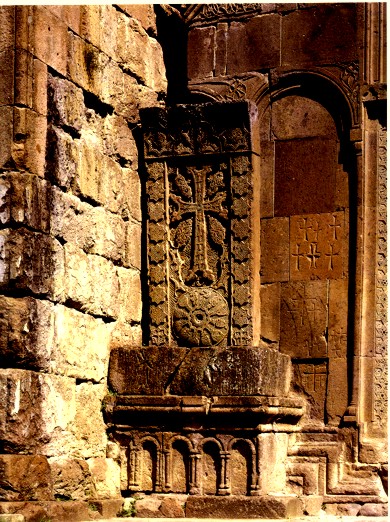
THE BEAUTIFUL CROSS-STONE OF GOŠAVANK‛
[1291] WHERE THE GREAT
MXIT‛AR GOŠ HAILED FROM.

CROSS-STONE OF GOŠAVANK‛
[DETAIL] BY MASTER PAVŁOS. PROFOUNDLY
SUBLIME COSMIC SYMBOLISM... THE 'ASEGHNAGORTS' [LIT. NEEDLE-WOVEN]
CROSS-STONE [DIVINE SPARK] NAMED BECAUSE OF THE PAINSTAKING, METICULOUS
EXQUISITE FINE WORK BY THE MASTER... IN THE FORM
OF Π [PHI/PI/1.618] ALL WITHIN HARMONIOUS GOLDEN MEAN...FROM THE 12-SPOKE
COSMIC WHEEL/ [EGG/VOID IN THE CENTER] EMERGES THE COSMIC AXIS CROSS
WITH TRADITIONAL ARMANI TRIUNE [3 DOTS] FLEUR-DE-LYS TIPS...THE OVARIES OF
THE GODDESS EMERGE FROM THE EGG AND GIVE BIRTH TO THE MASCULINE CROSS
FOUR CONES FLANKING THE FOUR-FOLD CROSS...TWO SETS OF NINE
SACRED
OCTAGRAMS ON THE RIGHT AND LEFT OF THE CRUX...+ TWO ABOVE...FLANKING
THE TRIPLE DECKER UNIVERSE THAT HAS THE WHOLE EXTENSION OF THE TREE
OF LIFE...MALE + FEMALE FUSION [DIVINE REUNION THROUGH COMPASSION/
HEART/LOVE WITH THE GODDESS] REPRESENTED WITH THE OCTAGRAMS
[NOTE THE TWO OCTAVES AT THE VERY BOTTOM THAT HAVE 2 CROSSES
IN THE FORM OF FOUR UNITED 'T's THAT ARE ACTUALLY TWO UNITED
SWASTIKAS SPINNING RIGHT AND LEFT...
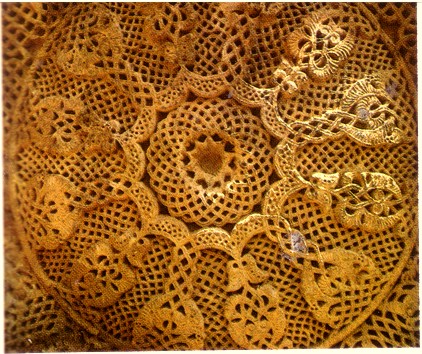
CLOSE UP OF THE COSMIC WHEEL WITH THE INTRICATE 'WOVEN' MATRIX
MADE BY
THE MASTER OF THE CRAFT...SHOWING THE PROFOUND SUBLIME SYMBOLISM
THAT IS THE TRUE ESSENCE OF THE GREAT WORK. OUT OF THE INITIAL VOID
EMERGES THE 10-POINTED STAR [PERFECT 10-DIMENSIONAL UNIVERSE...TWO
UNITED
FIVE-POINTED STARS] THE CORE IS SURROUNDED BY A TOROIDAL SPIRAL [BOLOR-AK
SPINNING RIGHT AND LEFT.. LIT. IN ARMAN ALL-WHEEL..] ASSOCIATED WITH
SPACE...
THE NEXT LAYER OF THE MATRIX IS MADE UP OF THE 12-POINTED SUNBURST
ASSOCIATED WITH TIME [PRECESSION...12 HOUSES OF THE ZODIAC, 12 MONTHS OF
THE YEAR, 12 HOURS OF DAY AND 12 HOURS OF NIGHT...ETC. OUT OF WHICH EMERGE
THE 12 RAYS OF INTERWOVEN SERPENTINE WINGED HERMETIC STAFF THAT HAS
THE VULVA/WOMB/DNA...THAT INCLUDES KHOY/RAM/ARIES [RIGHT AND LEFT SPIRALS]...
STANDING FOR THE MALE PRINCIPLE WITHIN THE ETERNAL FEMININE...

COAT OF ARMS OF THE PROSHIAN PRINCESS IN THE CHAPEL OF THE BURIAL
VAULT
OF THE NOBLE HOUSE IN CLIFF CHISELED WONDER MONASTERY OF GEŁARD
[LANCE].
The turmoil that was going on for more than two decades had by this period taken on catastrophic proportions. In 1042, some of the most notable figures of the aristocracy and the royal court were determined to take decisive action in order to stop the 'diplomatic' transfer of Ani and adjoining lands. Headed by the great military commander and a brilliant tactician, Vahram Pahlavuni, they decided to resist the Byzantine takeover [many within Armenia agitated for this move since Byzantium was considered an Armenian empire by the contemporaries] rather than lose their freedom and power as Byzantine vassals (strategoi).
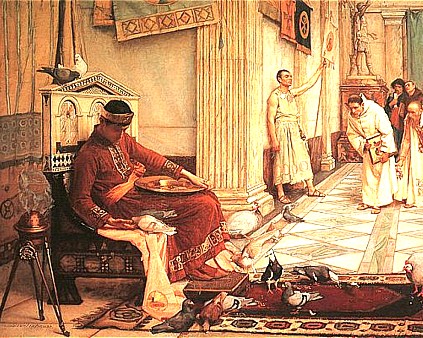
MANY LEADING ARMENIANS WERE SYMPATHETIC TO
THE BYZANTINE EMPIRE RULED BY KINGS AND QUEENS OF ARMENIAN DESCENT
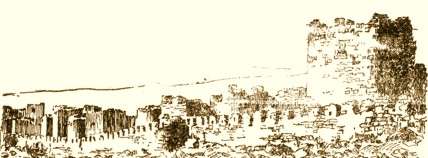
RUINS OF THE ONCE ENORMOUS MULTILAYERED WALLS OF THE
FORTRESS-CITY OF
KARS -- THE OLD BAGRATID CAPITAL WEST OF THE ARAXES RIVER.
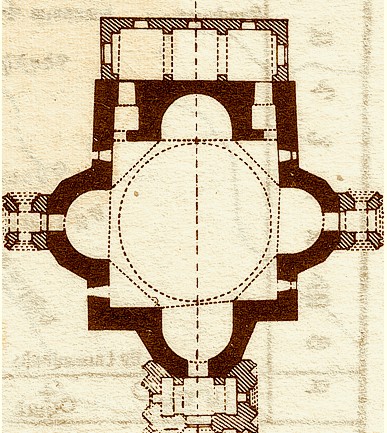
KARS. FLOOR PLAN OF THE CHURCH OF THE APOSTLES [XTH CENTURY]

THE CHURCH OF THE APOSTLES AS IT LOOKED IN EARLY XXTH CENTURY
BEFORE
THE DESTRUCTION OF THE BELFRY [ON THE RIGHT] BY THE TURKISH GOVERNMENT.

CHURCH OF MARINĒ IN ASHTARAK.
In 1042, as an ultimate act of defiance to simply hand over the city, the nobles proclaimed a new king, the eighteen year old son of Ashot III, Gagik, who was crowned as Gagik II. The Byzantine Emperor Michael IV and later Constantine Monomachus from the renowned Armenian dynasty, sent the imperial cohorts (the Anatolia legions were made up of the heavy Armenian cavalry and led by Armenian aristocracy fighting for Byzantium) in order to "dethrone the imposter king and exercise king's (Hovaness-Smbat's - G.N.) will."
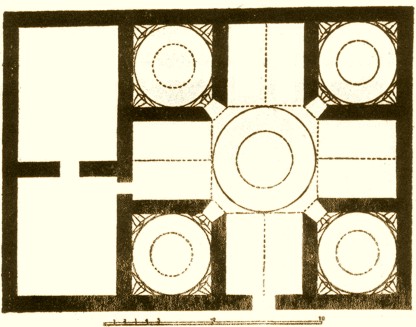
FLOOR PLAN OF A BATH ADJOINING THE TIGRAN HONENC‛
[1215]
MONASTERY
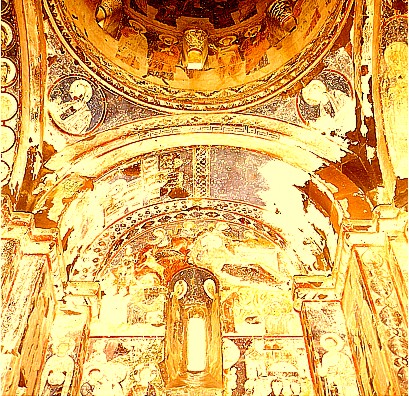
REMNANTS OF THE BEAUTIFUL FRESCOS INSIDE THE TIGRAN HONENC‛
MONASTERY
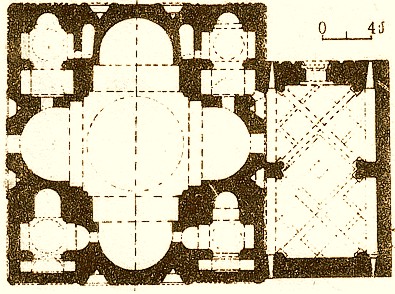
FLOOR PLAN OF ANI'S THE CHURCH OF THE APOSTLES [XITH
CENTURY]

A PAINTING DEPICTING THE CATHOLICOS AND KING GAGIK HOLDING
THE MODEL OF ANI'S GAGKASHEN CATHEDRAL -- ON TOP
OF THE SUN DIAL AND THE EAGLE OF THE ZVARTNOTS CATHEDRAL.
RELIEFS OF ZVARTNOTS CATHEDRAL AND THE ODZUN MONUMENT
IN THE BACKGROUND.
The Byzantine army besieged the city and unsuccessfully stormed the outer walls several times in order to break in. The three military expeditions of the Byzantine emperors were repelled, the last assault of Anatolia army turned out to be disastrous. In a daring counteroffensive led by Vahram Pahlavuni, the Byzantine forces were routed and decimated, losing more than 20,000 men under the walls of Ani. The heroic defense of the city by the small city garrison and mostly citizen militia under the leadership of Vahram, drove back the remnants of the imperial troops. The huge walls of Ani were a tough nut to crack for the Byzantines.

DIVINE FIRE/CREATION. SYMBOL OF COSMOS ON THE CITY'S GATES
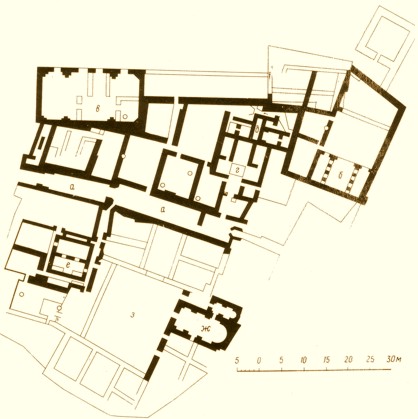
THE PALACE OF THE BAGRATIDS. TENTH CENTURY.
RECONSTRUCTION BY T‛OROS T‛ORAMANEAN
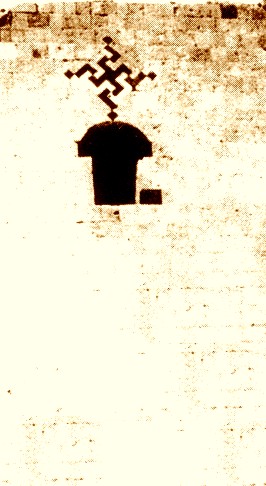
ARMAN SYMBOL OF ETERNITY INLAID HIGH ABOVE -- INSIDE THE HUGE
WALLS OF
THE CITY -- WITH TOWERING VISIBILITY -- IN HARMONIC RED-BLACK PATTERN.
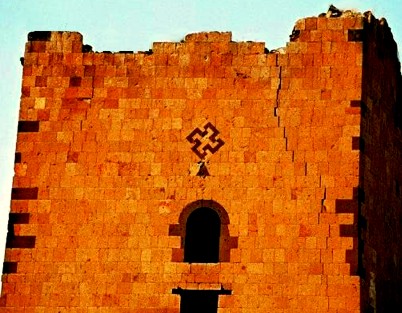
THE COSMIC SYMBOL WAS ALSO PLACED ABOVE THE ENTRY GATES TO THE
CITY
NOTE THE UPWARD POINTING COSMIC HIERARCHY TRIANGLE.

BEAUTIFUL DECORATIVE RELIEFS FROM THE BELL TOWER CEILING
OF HOROMOS MONASTERY. SUBLIME COSMIC SYMBOLISM.
FOUR-FOLD DIVISION WITH THE COSMIC WHEELS LEADING TO THE
CENTER CRUX.

FLOOR PLAN OF ONE OF THE HOTELS FOR INTERNATIONAL TRAVELERS
ABOVE AND BELOW. BEAUTIFULLY DECORATED XIIITH CENTURY
WRITING-DESKS FROM ANI SAVED BY A. K‛ALANT‛AR
IN 1918.
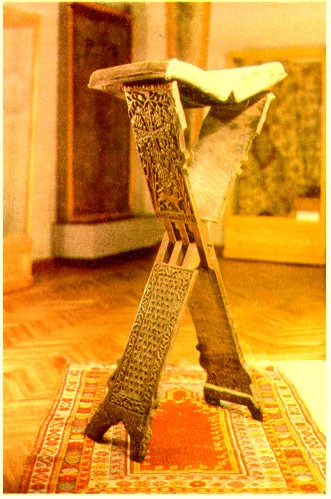
TWO INTERLOCKING 'V's...OR UNITED AV...FORMING AN X-SHAPE
CRUX COVERED WITH COSMIC SYMBOLS SUPPORTS THE MASSIVE
OPEN BOOK THAT CONTAINS DIVINE KNOWLEDGE AND WISDOM.
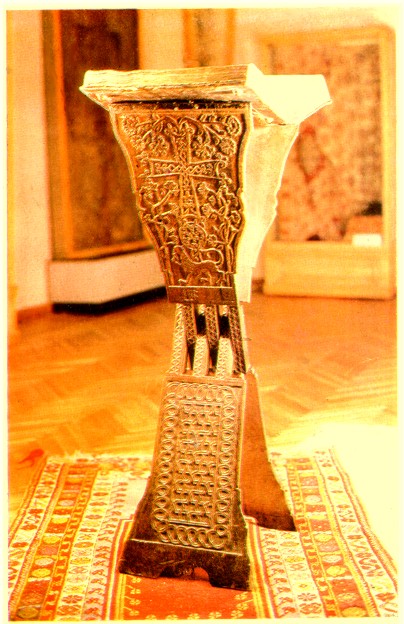
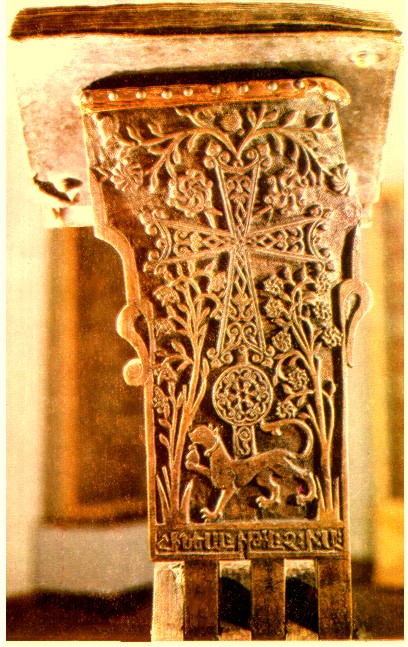

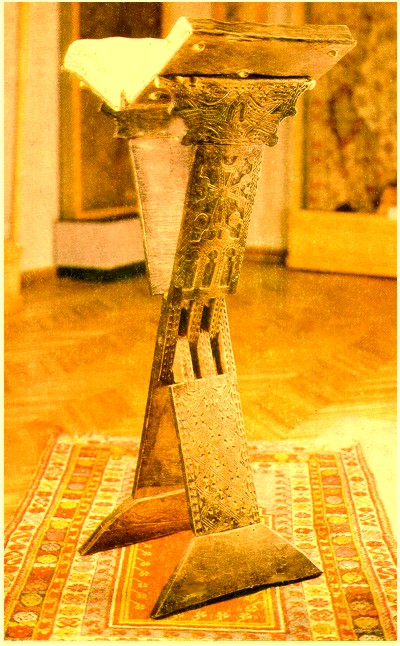
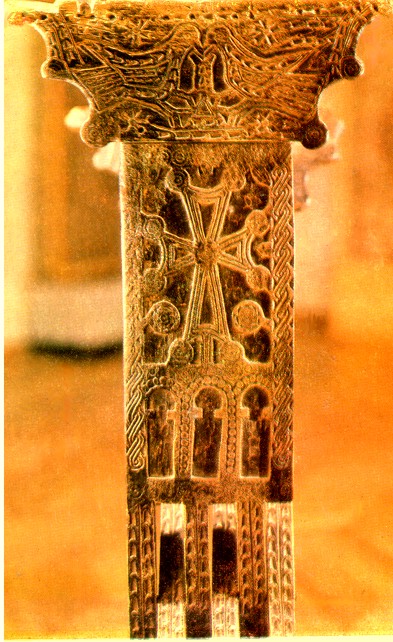
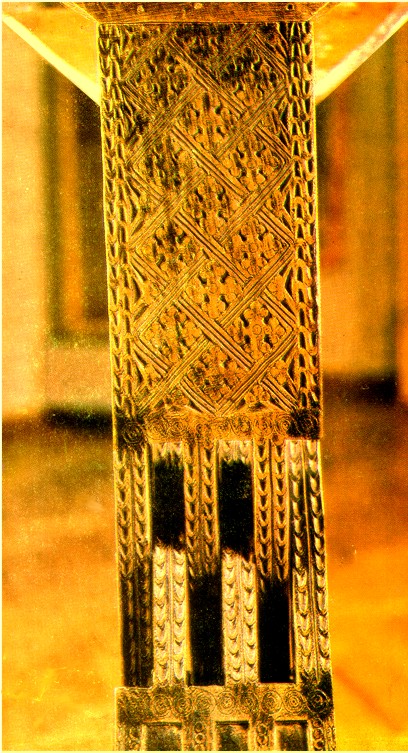
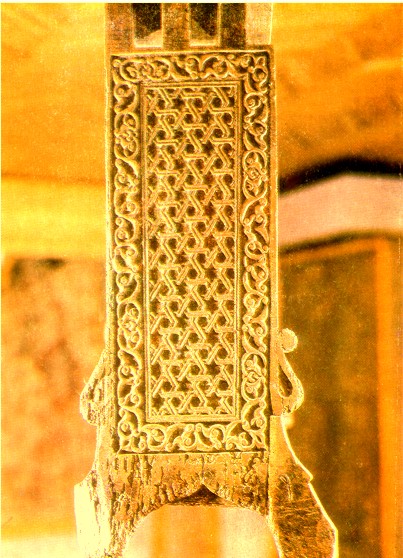

GENERAL PLAN OF ONE OF THE RESIDENTIAL QUARTERS OF THE CITY
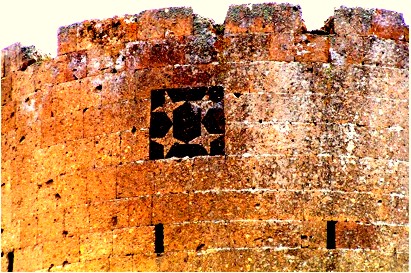
S U B L I M E
A R M A N I S Y M
B O L I S M O N A N I' S
W A L L S.
Seeing that Ani cannot be conquered by force (the stick), the Byzantines began to play the diplomatic game (the carrot) in order to appease some of the prominent leaders of the city. Emperor Constantine, called Gagik II to Constantinople for diplomatic negotiations, giving the Armenian king his "word" that he will not be harmed. Most of the nobles, including Vahram Pahlavuni opposed the decision of the King Gagik II to agree to go to the Byzantine capital. Remembering previous cases of the treacherous "promises" of the Byzantine court. Many Emperors of the Byzantine Empire were of Armenian origin, even an Armenian (Macedonian) dynasty was established, with the powerful Emperors like Leo V (813 - 20) and Basil I, who established the Armenian-Macedonian dynasty in 867.
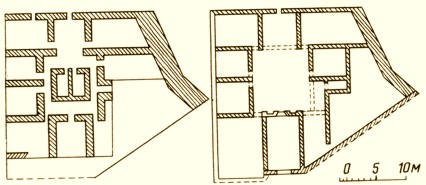
THE PALACE OF BARON. XII-XIII CENTURIES. THE BASEMENT
[LEFT]
AND THE FIRST FLOOR. RECONSTRUCTION BY T. T‛ORAMANEAN
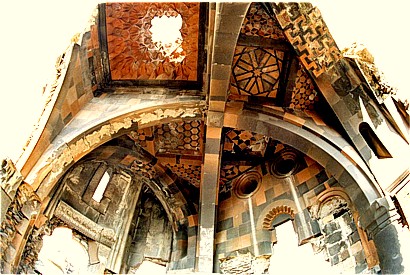
INSIDE THE RUINS OF THE CHURCH OF THE APOSTLES... THE TRADITIONAL
ARMENIAN CROSSED ARCH WOULD LATER INFLUENCE GOTHIC ARCHITECTURE.
THE CROWN DOME IS IMBUED WITH SACRED SYMBOLS.
This however had nothing to do with Armenians and Armenia. The emperors, whether of Armenian origin or not, always placed and pursued the interests of the Byzantine empire at exclusive forefront. Their Armenian descent was virtually a non factor when it came towards the imperial foreign policy in Greater Armenia and/or Cilician Armenia.

FLOOR PLAN OF THE GATES OF KARUC‛.
RECONSTRUCTION BY NIKOLAI MARR.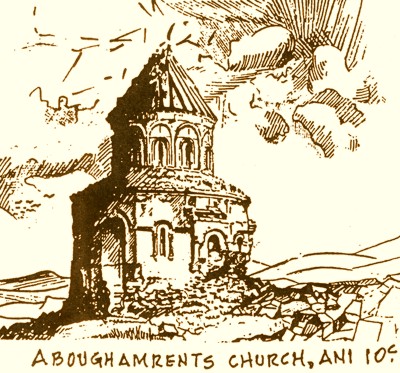
RUINS OF ABUŁAMRENTS. XTH
CENTURY.

RUINS OF THE ONCE GLORIOUS ANI CATHEDRAL TODAY...
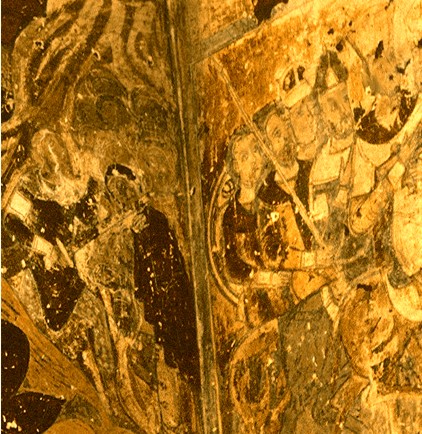
FROM THE ONCE BRIGHT AND NOW ERODED FRESCOES OF TIGRAN HONENTS CHURCH
[1215]. DETAIL DEPICTING KING TRDAT III RIDING OUT WITH HIS ROYAL BODYGUARD.
NOTE THE ARMENIAN CAVALIER ON THE RIGHT.

THE RUINS OF TIGRAN HONENTS CHURCH.
Catholicos Peter I Getadardz and some of the leading nobles like Vest Sarkis told Gagik II, that the Christian emperor will not resort to "deceitfulness" if the latter has given his "word." In addition to this "advice," the pro-Byzantine faction, unknowingly to the King and Vahram Pahlavuni, as a symbolic gesture of surrender, sent the keys of the city to Emperor Constantine.
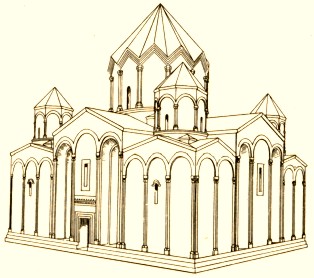
SCHEMATIC RECONSTRUCTION OF ANI'S CHURCH OF THE APOSTLES
ADORNED WITH
FIVE SACRED CONIC DOMES [FOUR SIDES LEADING TO THE FIFTH IN THE CENTER]
RECON. BY ARCHITECT N. M. TOKARSKI. EXTERIOR VIEW FROM THE SOUTH-EASTERN ANGLE
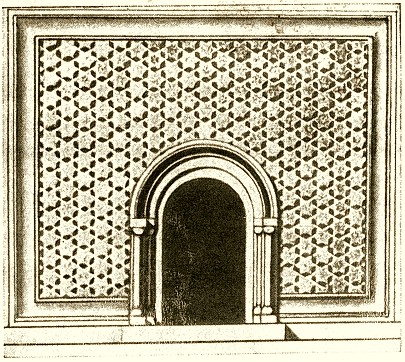
T H E P O R T I C O O F S A R
K I S' P A L A C E. X I I I C E N T U R Y
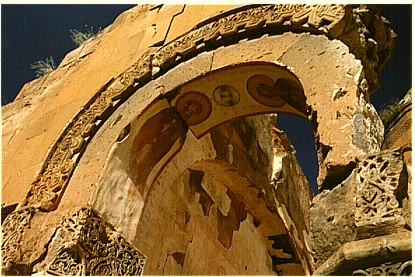
AN ARCHWAY LEADING TO THE RUINS OF THE CHURCH OF THE APOSTLES
THAT IS
ROTTING AWAY...THE ELEMENTS ARE GRADUALLY WEATHERING AWAY WHAT
REMAINS OF THE WONDER CHURCH AND THE WEED IS CRACKING AND
KNOCKING OUT MORE AND MORE STONE BLOCKS OF THE HOLY SHRINE
WITH EACH PASSING YEAR...
After a prolonged struggle and refusal to sign the ill conceived "agreement," King Gagik II, in 1045 was pressured by the Catholicos under the threat of excommunication to sign the treaty under which Ani and surrounding territories were to become part of the Byzantine Empire. This in effect ended the Bagratid Royal House and the Kingdom of Armenia. The Emperor, in exchange for the handover of the city, promised King Gagik, to grant an "autonomous rule" to Ani. Emperor Constantine also gave King Gagik II small possessions in Cappadocia, including the city of Pisu, the palace of Colon and the adjoining territories.

FLOOR PLAN OF ONE OF CITY'S OLIVE REFINERIES.

FRESCO ON THE CEILING OF A CAVE CHURCH [JUST LIKE ANCESTRAL MITHRÆA
INSIDE
THE SACRED CAVES - ROCK SYMBOLIZING THE DIVINE SPARK WITHIN] OUTSIDE ANI.
Many years later, the
last Bagratuni monarch, King Gagik II, was killed in the treacherous court
intrigue of the imperial capital. With King Gagik's assassination, the
Byzantines removed a possible threat and a symbol of decapitated Armenian
monarchy. The so-called open city (proclaimed by Catholicos Peter and Vest
Sarkis) of Ani was occupied by the Byzantine troops circa 1045. The Byzantines
instated the rule of governors strategoi (captains) who became the rulers
for most of Greater Armenia, including Ani, which by this time had considerably
lost its former prestige as a direct result of the wars and instability that
began in the early part of the XIth century.

FURTHER READING | HIGHLY RECOMMENDED:
VIRTUAL ANI -- A
TRULY GREAT SITE
SPECIFICALLY DEDICATED TO THE CITY OF ANI
http://www.virtualani.freeserve.co.uk/